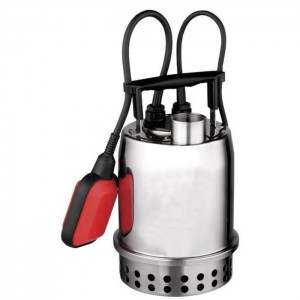 Honda’s WSP33 can control water levels in ponds and help keep basements dry, but the safety issues of such a device are obvious: it has a powerful motor, it’s constantly surrounded by water and it has household AC current being sent to it. Proper installation and use can all but eliminate the chance of fire and electrocution while providing reliable protection against flooding.
Honda’s WSP33 can control water levels in ponds and help keep basements dry, but the safety issues of such a device are obvious: it has a powerful motor, it’s constantly surrounded by water and it has household AC current being sent to it. Proper installation and use can all but eliminate the chance of fire and electrocution while providing reliable protection against flooding.
Installation/Operation Safeguards
This pump is designed to operate when fully submerged: water needs to surround the housing to keep the motor cool. Because of this, the pump must be shut off if the water level drops below the motor housing. If used with an automatic float switch, the float needs to move freely to cycle the pump on and off. Any possible obstructions should be moved away from the switch, and the switch should be at a height that turns the pump on when the water is 13-14 inches (33-35.5 cm) high. To adjust the float height, reposition the float switch cable in the clamp on the top of the pump.
The WSP33 is designed to pump clean water no warmer than 122°F (50°C) containing suspended solids up to 3/16 of an inch (4.8 mm) in diameter. However, pumping hard materials like sand will shorten the life of the pump even if they’re well under the maximum diameter. Pumping water from a container or pond with a layer of debris on the bottom? Placing the pump on a support to keep it off the surface will reduce the amount of debris going through the impeller.
Electrical Requirements
The power cord must be plugged into a three prong outlet that is wired with a separate ground. The third “ground” prong is needed to transfer electricity away from the pump in case a bare wire comes in contact with the metal housing. Using a three into two prong adapter or a non-grounded outlet disables this safety feature.
This pump should be protected with a GFCI (ground-fault circuit interrupter) breaker or a fuse and separate GFCI outlet. A GFCI measures the difference between the hot wire and the ground wire, automatically shutting off the current if there is a difference of more than a few milliamps. That means if there is a new path for electricity to flow, such as into the water via an exposed power cable, it cuts off the power, preventing possible electrocution. The fuse or breaker should be rated for a minimum of 15 amps.
This pump cannot be installed in places considered hazardous by National Electric Code standard ANSI/NFPA 70. In essence, this includes any area that may contain ignitable concentrations of flammable gases, vapors, liquids, dust, fibers or other materials under any operating conditions. Common household situations that would violate this code include gas can storage, gas appliances, dryer vents and anything related to woodworking. If in doubt, consult an electrician.
The basin the pump is placed in should be made of a non-conductive material like plastic, fiberglass or concrete.
The pump is designed to work with 115 Volt AC current at 60 Hz. Electricity that is more than 10 percent higher or lower than this voltage can damage the pump motor. Household electricity in North America usually falls well within this range, but power from a generator may not: be sure to check the voltage before switching on the pump.
Maximum distance between the power source and the pump can be no more than 100 feet (30.5 meters) when using standard 16-3 electrical wire. If you need to connect the pump to a power source over greater distances consult a professional electrician or a Honda certified dealer.
Proper Lifting
Never lift this pump by the electrical cable. Instead, tie a rope or chain to the handle to lower and lift the pump.
Where to buy Honda Pump parts
Need to service your submersible pump? www.hondalawnparts.com has all the OEM parts you need to keep any of Honda’s power equipment from pumps to snowblowers in top condition.
